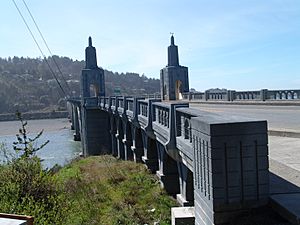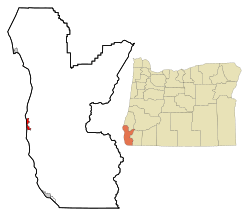Gold Beach, Oregon facts for kids
Quick facts for kids
Gold Beach, Oregon
|
|
|---|---|

Isaac Lee Patterson Bridge over Rogue River in Gold Beach
|
|

Location in Oregon
|
|
| Country | United States |
| State | Oregon |
| County | Curry |
| Incorporated | 1853 |
| Area | |
| • Total | 2.77 sq mi (7.17 km2) |
| • Land | 2.53 sq mi (6.56 km2) |
| • Water | 0.23 sq mi (0.60 km2) |
| Elevation | 23 ft (7 m) |
| Population
(2020)
|
|
| • Total | 2,341 |
| • Density | 923.84/sq mi (356.76/km2) |
| Time zone | UTC-8 (Pacific) |
| • Summer (DST) | UTC-7 (Pacific) |
| ZIP code |
97444
|
| Area code(s) | 541 |
| FIPS code | 41-29900 |
| GNIS feature ID | 2410609 |
| Website | Gold Beach, Oregon |
Gold Beach is a city located on the beautiful Oregon Coast in the United States. It is the main city, or county seat, of Curry County. In 2020, about 2,341 people lived there. The local Tolowa people have their own names for this area: yan-shu’-chit and yan-shuu-chit’-dvn.
Contents
History of Gold Beach
The area was first called Ellensburg in the 1850s. Later, it got the name Gold Beach. This name came from a nearby beach at the mouth of the Rogue River. Hundreds of people found gold there by placer mining.
A post office was set up in Ellensburg in 1853. Its name changed to Gold Beach in 1890.
Since 1895, special mailboats from Gold Beach have delivered mail up the river to Agness. This is one of only two rural mailboat routes still running in the U.S.
Gold Beach has been a community since the mid-1800s. It became the county seat in 1859. The city officially became incorporated in 1945.
Geography and Location
Gold Beach is located in Oregon, on the Pacific Coast. The United States Census Bureau says the city covers about 2.76 square miles (7.17 square kilometers). Most of this area is land, with a small part being water.
The city is bordered to the north by the Rogue River. Another nearby area is called Barley Beach, also known as Bailey Beach.
Gold Beach Climate
Gold Beach has cool, very wet winters. Its summers are mild and usually dry. The nearby Pacific Ocean greatly affects the weather. This means the temperatures do not change much throughout the year.
Gold Beach has a warm-summer Mediterranean climate. This type of climate is known for its dry, warm summers and mild, wet winters.
Between 1948 and 2014, the average high temperature in January was about 54°F (12°C). The average low was about 41°F (5°C). In July, the average high was about 68°F (20°C). The average low was about 51°F (11°C).
Very hot days are rare in Gold Beach. Temperatures of 90°F (32°C) or higher happen only about 0.1 days a year. Freezing temperatures (32°F or 0°C) happen about 9.2 days a year. The hottest temperature ever recorded was 102°F (39°C) on September 10, 1973. The coldest was 12°F (-11°C) on January 21, 1962.
Gold Beach gets a lot of rain, about 80 inches (203 cm) each year. Most of the rain falls between October and April. It rains on about 132 days a year. Snow is very rare, with only about 0.2 inches (0.5 cm) annually.
| Climate data for Gold Beach, Oregon, 1991–2020 normals, extremes 1948–present | |||||||||||||
|---|---|---|---|---|---|---|---|---|---|---|---|---|---|
| Month | Jan | Feb | Mar | Apr | May | Jun | Jul | Aug | Sep | Oct | Nov | Dec | Year |
| Record high °F (°C) | 74 (23) |
81 (27) |
80 (27) |
82 (28) |
86 (30) |
90 (32) |
89 (32) |
88 (31) |
95 (35) |
91 (33) |
76 (24) |
72 (22) |
95 (35) |
| Mean maximum °F (°C) | 64.3 (17.9) |
66.3 (19.1) |
66.6 (19.2) |
69.4 (20.8) |
73.3 (22.9) |
76.1 (24.5) |
78.3 (25.7) |
78.5 (25.8) |
81.3 (27.4) |
77.4 (25.2) |
67.1 (19.5) |
63.2 (17.3) |
84.6 (29.2) |
| Mean daily maximum °F (°C) | 54.7 (12.6) |
55.4 (13.0) |
56.7 (13.7) |
58.6 (14.8) |
62.3 (16.8) |
65.4 (18.6) |
68.1 (20.1) |
68.6 (20.3) |
68.8 (20.4) |
64.1 (17.8) |
57.2 (14.0) |
54.0 (12.2) |
61.2 (16.2) |
| Daily mean °F (°C) | 48.7 (9.3) |
48.9 (9.4) |
49.7 (9.8) |
51.4 (10.8) |
54.8 (12.7) |
57.7 (14.3) |
60.6 (15.9) |
60.9 (16.1) |
60.3 (15.7) |
56.4 (13.6) |
50.9 (10.5) |
47.9 (8.8) |
54.0 (12.2) |
| Mean daily minimum °F (°C) | 42.7 (5.9) |
42.3 (5.7) |
42.7 (5.9) |
44.2 (6.8) |
47.2 (8.4) |
50.1 (10.1) |
53.0 (11.7) |
53.2 (11.8) |
51.7 (10.9) |
48.8 (9.3) |
44.6 (7.0) |
41.7 (5.4) |
46.9 (8.3) |
| Mean minimum °F (°C) | 33.2 (0.7) |
32.9 (0.5) |
34.2 (1.2) |
36.2 (2.3) |
40.5 (4.7) |
44.0 (6.7) |
47.8 (8.8) |
47.3 (8.5) |
44.7 (7.1) |
40.2 (4.6) |
34.8 (1.6) |
32.7 (0.4) |
29.1 (−1.6) |
| Record low °F (°C) | 12 (−11) |
21 (−6) |
26 (−3) |
28 (−2) |
31 (−1) |
35 (2) |
36 (2) |
34 (1) |
37 (3) |
31 (−1) |
25 (−4) |
16 (−9) |
12 (−11) |
| Average precipitation inches (mm) | 11.97 (304) |
9.68 (246) |
10.31 (262) |
7.09 (180) |
3.45 (88) |
1.76 (45) |
0.27 (6.9) |
0.46 (12) |
1.41 (36) |
4.91 (125) |
10.69 (272) |
13.18 (335) |
75.18 (1,910) |
| Average precipitation days | 18.3 | 17.2 | 18.8 | 15.5 | 10.5 | 5.9 | 2.3 | 2.8 | 4.8 | 12.1 | 18.6 | 18.6 | 145.4 |
| Source 1: NOAA | |||||||||||||
| Source 2: NOAA NCEI | |||||||||||||
Population of Gold Beach
| Historical population | |||
|---|---|---|---|
| Census | Pop. | %± | |
| 1890 | 200 | — | |
| 1900 | 112 | −44.0% | |
| 1910 | 125 | 11.6% | |
| 1920 | 321 | 156.8% | |
| 1930 | 500 | 55.8% | |
| 1940 | 500 | 0.0% | |
| 1950 | 677 | 35.4% | |
| 1960 | 1,765 | 160.7% | |
| 1970 | 1,554 | −12.0% | |
| 1980 | 1,515 | −2.5% | |
| 1990 | 1,546 | 2.0% | |
| 2000 | 1,897 | 22.7% | |
| 2010 | 2,253 | 18.8% | |
| 2020 | 2,341 | 3.9% | |
| source: | |||
2010 Census Information
In 2010, there were 2,253 people living in Gold Beach. These people lived in 1,070 households. About 614 of these were families. The city had about 890 people per square mile (344 people per square kilometer).
Most of the people living in Gold Beach were White (91.5%). A small number were Native American (2.0%) or Asian (0.8%). About 4.9% of the population was Hispanic or Latino.
In terms of households, 19.8% had children under 18 living there. About 43.2% were married couples. Many households (42.6%) were not families. About 37.8% of all households had only one person living there.
The average age of people in Gold Beach was 50.6 years old. About 16.5% of residents were under 18. About 22.7% were 65 years or older. The population was almost evenly split between males (48.5%) and females (51.5%).
Education in Gold Beach
Students in Gold Beach attend schools within the Central Curry School District. The main schools in the city are Riley Creek School and Gold Beach High School.
The entire county is also part of the Southwestern Oregon Community College district. This means students can attend college classes there.
Famous People from Gold Beach
- Gregory Harrison — a well-known actor who lived in Gold Beach for 15 years.
- Travis Rush — a country music singer who grew up in Gold Beach.
- Bridgette Wilson — an actress and former beauty queen. She was born and raised in Gold Beach. She won Miss Oregon Teen USA in 1990 and then Miss Teen USA 1990.
Transportation
- Gold Beach Municipal Airport is located here.
Media
Newspapers
The local newspaper for the region is The Curry County Reporter. It has been publishing news since 1914.
Radio
- KGBR 92.7 FM - This radio station plays classic hits music.
See also
 In Spanish: Gold Beach (Oregón) para niños
In Spanish: Gold Beach (Oregón) para niños

